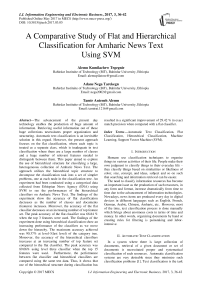A Comparative Study of Flat and Hierarchical Classification for Amharic News Text Using SVM
Автор: Alemu Kumilachew Tegegnie, Adane Nega Tarekegn, Tamir Anteneh Alemu
Журнал: International Journal of Information Engineering and Electronic Business(IJIEEB) @ijieeb
Статья в выпуске: 3 vol.9, 2017 года.
Бесплатный доступ
The advancement of the present day technology enables the production of huge amount of information. Retrieving useful information out of these huge collections necessitates proper organization and structuring. Automatic text classification is an inevitable solution in this regard. However, the present approach focuses on the flat classification, where each topic is treated as a separate class, which is inadequate in text classification where there are a large number of classes and a huge number of relevant features needed to distinguish between them. This paper aimed to explore the use of hierarchical structure for classifying a large, heterogeneous collection of Amharic News Text. The approach utilizes the hierarchical topic structure to decompose the classification task into a set of simpler problems, one at each node in the classification tree. An experiment had been conducted using a categorical data collected from Ethiopian News Agency (ENA) using SVM to see the performances of the hierarchical classifiers on Amharic News Text. The findings of the experiment show the accuracy of flat classification decreases as the number of classes and documents (features) increases. Moreover, the accuracy of the flat classifier decreases at an increasing number of top feature set. The peak accuracy of the flat classifier was 68.84 % when the top 3 features were used. The findings of the experiment done using hierarchical classification show an increasing performance of the classifiers as we move down the hierarchy. The maximum accuracy achieved was 90.37% at level-3(last level) of the category tree. Moreover, the accuracy of the hierarchical classifiers increases at an increasing number of top feature set compared to the flat classifier. The peak accuracy was 89.06% using level three classifier when the top 15 features were used. Furthermore, the performance between flat classifier and hierarchical classifiers are compared using the same test data. Thus, it shows that use of the hierarchical structure during classification has resulted in a significant improvement of 29.42 % in exact match precision when compared with a flat classifier.
Automatic Text Classification, Flat Classification, Hierarchical Classification, Machine Learning, Support Vector Machine (SVM)
Короткий адрес: https://sciup.org/15013509
IDR: 15013509
Текст научной статьи A Comparative Study of Flat and Hierarchical Classification for Amharic News Text Using SVM
Published Online May 2017 in MECS
Humans use classification techniques to organize things in various activities of their life. People make their own judgment to classify things in their everyday life – they classify things based on similarities or likeliness of color, size, concept, and ideas, subject and so on such that searching and information retrieval can be easier.
The need to classify information resources has become an important issue as the production of such resources, in any form and format, increase dramatically from time to time due to the advancement of information technologies. Nowadays, news items are produced every day in digital devices in different languages such as English, French, German, Arabic, Chinese, Amharic, etc. However, most of the time, text classification process is done manually which brings about enormous costs in terms of time and money. In other words, organizing documents by hand or creating rules for filtering is painstaking and laborintensive.
-
II. Automatic Text Classification
In a system where there is large collection of documents, retrieval of a given document or set of documents is necessitated proper and systematical classification of such resources. Automatic classification systems are very desirable since they minimize such classification problems [1]. Text classification is the task of automatically assigning a set of documents into categories (or classes, or topics) from a predefined set [2]. If C= {c1, c2…cm} is a set of categories (classes) and D= {d1,d2,…,dn} is a set of documents, the purpose of text classification is assigning ci to dj (1≤i≤m and 1≤j≤n) a value of 0 if the document dj does not belong to ci ; otherwise a value of 1.
Automatic document classification can be done either by treating each category/topic independently of one another (flat classification) or by considering the structural relationship among a given categories (hierarchical classification).
-
A. Flat classification
In a flat classification, the predefined categories are treated individually and equally so that no structures exist to define relationships among them [3]. A single huge classifier is trained which categorizes each new document as belonging to one of the possible predefined classes.
In a flat classification approach, as we use a large corpus we may have hundreds of classes and thousands of features, the borderlines between document classes are blurred; and the computational cost of training a classifier for a problem of this size is prohibitive. In such approaches, there will have many thousands of parameters which need to be estimated, the resulting classifier will have also a large variance, and thus it will lead to overfitting of the training data.
-
B. Hierarchical classification
Hierarchical text classification is proposed by [4], as divide-and-conquer approach that utilizes the hierarchical topic structure to decompose the classification task into a set of simpler problems, one at each node in the classification hierarchy. Rather than ignoring the topical structure and building a single huge classifier for the entire task, we use the structure to break the problem into manageable size pieces. As shown in figure 1, in such a hierarchical structure document types become more specific as we go down in the hierarchy.
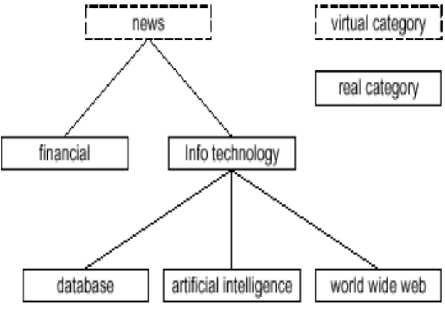
Fig.1. Sample hierarchical structure
-
III. Related Literature
The study is conducted on large collection of Amharic news text released by Ethiopian News Agency (ENA). Amharic is the native language of people living in the north central part of Ethiopia. It is the working language of the Federal Republic of Ethiopia. There are significant number of immigrants who speak Amharic in the Middle East, Asia, Western Europe and North America [5]. The language has its own writing system that uses the Ge’ez alphabet.
Recently, there are numerous electronic documents produced and stored in Amharic language. More specifically, ENA produces and stores more than 100,000 news articles [6] with a total of 110 categories.
However, using manual classification for such large number of classes brings about enormous costs in terms of time and money. To cope up with these challenges a couple of studies have been done [7], [8], and [9]. However, all attempts are done with flat classification approach. In such a situation, the result of their studies showed that the accuracy of the classifier degrades as the number of categories (classes) and the number of document features increases. In a hierarchical classification approach, however, the classifier is only focus on the relevant features of the classes since the number of classes and documents decreases as we go down the classification tree. The aim of this study is, therefore, to explore the possibility of designing and developing hierarchical news text classifier that is effective and efficient in classifying large, heterogeneous collection of Amharic news text.
-
IV. Methodology
-
A. Data source
Table 1. Statistics of data collected from ENA (2007-2010)
|
No |
Major class |
No. of Subclass |
No. of docs (2007-2010) |
|
1 |
Culture and Tourism ( ባህልና ቱሪዝም ) |
9 |
791 |
|
2 |
Economy ( ኢኮኖሚ ) |
11 |
1134 |
|
3 |
Education ( ትምህርት ) |
14 |
1117 |
|
4 |
Health ( ጤና ) |
11 |
1067 |
|
5 |
Law and Justice ( ህግናፍትህ ) |
6 |
704 |
|
6 |
Politics ( ፖለቲካ ) |
9 |
1136 |
|
7 |
Social ( ማህበራዊ ) |
11 |
1064 |
|
8 |
Sport ( ስፖርት ) |
7 |
523 |
|
9 |
Accident ( አደጋ ) |
3 |
2102 |
|
10 |
Weather and Environmental Protection ( የአካባቢ ጠበቃና የአየር ሁኔታ ) |
5 |
2203 |
|
11 |
Relations, Defense, and Security ( ግንኙነት፣ መከላከያና ደህንነት ) |
8 |
2017 |
|
12 |
Science and Technology ( ሳይንስና ቴክኖሎጂ ) |
4 |
1150 |
|
Total |
98 |
15008 |
The data used in the study is taken from Ethiopian News Agency (ENA). As shown in table 1, a total of 15008 Amharic news texts from 12 major classes and 98 subclasses have been collected.
-
B. Document Preprocessing
major (level-0) classes, 20 level- 1 classes and 69 level-2 classes with 5100 documents are generated.
Table 2. Results of the flat classifier when 8, 20, 69 classes are used
|
No.of classes |
No. of documents |
Accuracy (%) |
||
|
Training set |
Testing set |
Total |
||
|
8 |
1785 |
765 |
2550 |
80.34 |
|
20 |
2499 |
1071 |
3570 |
66.09 |
|
69 |
3213 |
1377 |
4590 |
50.32 |
Moreover, the stemming and stop word removal algorithm of [10] have been implemented and used in the study. As a result, a total of 189877 features are generated in all document preprocessing techniques. Such feature are used in a tf*idf calculation. More specifically, the architecture in figure 2 has explained the efforts made while undertaking the whole experiment up to building the model/classifier.
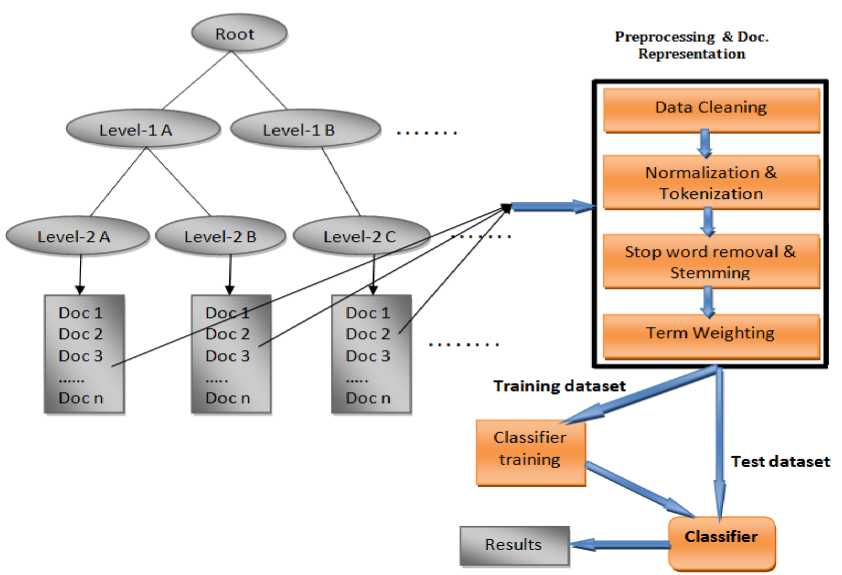
Fig.2. Architecture of the Hierarchical Amharic News Text Classifier
-
C. Support Vector Machine (SVM)
SVM is a method for supervised learning, applicable to both classification and regression problems. SVM uses a nonlinear mapping to transform the original training data into a higher dimension [12][13]. Within this new dimension, it searches for the linear optimal separating hyperplane (a decision boundary separating the instances of one class from another). Data from two classes can always be separated by a hyperplane, with an appropriate nonlinear mapping to a sufficiently high dimension. The SVM finds this hyperplane using essential instances from the training set called support vectors [11].
A growing number of machine learning methods have been applied to text categorization, such as Naïve Bayesian, Bayesian Network, Decision Tree, Neural network, Linear Regression, K-Nearest Neighbor, and Boosting. However, most machine learning methods overfit the training data when many features (high dimension vectors) are given [14]. Whereas, most researches [15][16] indicate that SVM is robust even when the number of features is large. Hence, SVM is selected for this study due to its capability of support high dimensional input space so that it can deal with large data sets; and tend to be less prone to over fitting since the learned classifier is characterized by the number of support vectors rather than the dimensionality of the data.
-
D. Tools and Input File Preparation
Support Vector Machine (SVM), is a method for supervised learning, applicable to both classification and regression problems. It has been implemented using LibSVM multiclass tool. For a training set (x1,y1) ... (xn,yn) with labels yi in [1..k], it finds the solution of the following optimization problem during training.
min w , b Л
l
1W T W + C^
2 i = 1
subject to yt(Wт ф (0Xt ) + b ) > 1 - ^ , (1)
^ > 0. for all y in [1... k ]
The data was prepared according to the requirement of LibSVM in the following format.
[line].=. [label] [index1]:[value1] [index2]:[value2] ...
[line] .=. [label] [index1]:[value1] [index2]:[value2] ...
Where,
Label (target value): Sometimes referred to as 'class', the class (or set) of classification and its values are integers.
Index (feature number): Ordered indexes. Usually continuous integers
Value (feature value): The data for training which contains term weights.
-
E. Running LibSVM
SVMmulticlass consists of a learning module (svm_multiclass_learn) and a classification module (svm_multiclass_classify). The learning module takes the files to be learned. It learns the characteristics of the data and develops the model or classifier. It has the following format:
svm_multiclass_learn[options]training_example_file model_file
Where,
-
- svm_multiclass_learn is the learning module.
-
- options are the kernel functions and their parameters given to learning module to train the example file. Linear kernel and C=0.01 are some of the default values in LibSVM
-
- training_example_file is a file containing training instances (a file to be learned)
-
- model_file is the learned rule generated by the classification module using the selected parameters
In the other hand, the classification module can be used to apply the learned model to new examples. It has the following format:
svm_multiclass_classify [options] test_example_file model_file output_file
Where,
-
- svm_multiclass_classify is the classification module.
-
- options are functions and parameters
-
- test_example_file a file containing test instances (a file used to test a learned model).
-
- model_file the learned rule generated by the classification module on which the test_example_file is tested.
-
- output_file is a standard output of a classification/prediction result.
For all test examples in test_example_file the predicted classes (and the values of x • wi for each class) are written to output_file . There is one line per test example in output_file in the same order as in test_example_file . The first value in each line is the predicted class, and each of the following numbers is the discriminate values for each of the k classes. For e.g, given a testing file, 2 1:1.08889 2:2.1978 3:0.9634
the output_file results the following output Class 1 2 3
Prediction 2 -0.067107 0.112766 -0.045659
SVM compares the prediction of each class and then the class with the maximum value is assigned to the test file. Thus, the above example shows that the test example is correctly predicted as class 2 among 3 classes.
-
F. Performance Measures
After models are trained by solving the above optimization problems, users can apply LibSVM to predict labels (target values) of test data. Let x1,….,xn be test data and f(x1),…., f(xn) be LibSVM’s predicted decision values (target values for classification). If the true labels (target values) of test data are known and denoted as y1,….,yn, the predictions are evaluated by the following measures.
no of correctly accuracy =
x100
no of total data set
-
G. Training data
The number of news documents used in this experiment was 5100. Since hierarchical classification emphasizes the relationship among classes, rather than building single huge classifier, a classification is accomplished with the cooperation of classifiers built at each level of the tree. The training data is organized into 3 levels: from level-0(root level) to level-2. Each level represents classes or subclasses in a classification tree. Thus, there were 8 classes at level-0, 20 classes at level-1, and 69 classes at level-2 with at least 14 documents in them. The classifiers at each level were trained using the associated documents of all subclasses of that class. Thus, the level-0 classifier was trained using documents of all subclasses of that class from level-1 through 2. In contrast, each level-1 classifier was trained with documents from the appropriate level-1 subclasses up level-2.
-
H. Test data
We tested the accuracy of the classifier using the test data selected from each level-3 documents. These documents were excluded from the training process and were selected from different level-3 classes. Since the class from which the test documents were selected is known, the accuracy of the classifier is evaluated how often the classifier assign the test documents to the classes from which they originally came. Moreover, we used the accuracy of classification (see equation 2) as an evaluation measure.
-
V. Results and Discussions
The experiment has been done based on the concepts explained at section IV part (G) and (E) and the result is discussed as follows:
-
A. Effects of the number of classes and documents on flat classification
We created a single classification system by training a flat classifier for all classes in the top 3 levels of the classification tree, ignoring structure. In other words, each of the 97 classes was trained using 70% of the documents from each class. We had broken the classification process into pieces of classes taken separately at a time to see the performance of the classifier while increasing number of classes and documents (features). Since each document is assigned in the leaf node of the classification tree; level-0 classes will have the same number of documents as that of level-1 and level-2 when used separately for the next corresponding experiment. Hence, we selected documents using 50% of the collection to experiment on level-1 classes, and 70% of collection for the second experiment and 90% of the document collection for the third experiment.
From the above three experiments, it was found that the accuracy decreases when the number of classes increased from 8 to 20 and then to 69; and the number of documents increased from 2550 to 3570 and then to 4590. Moreover, the average accuracy obtained from the above three experiments was 65.58%, which were decreased at each steps of the experiment. This shows that as the number of classes and documents increase, the performance of a flat classifier decreases. This is because, as the number of documents is increasing, the number of support vectors increases. Since the classification is done in a multidimensional plane where we can draw a number of hyper planes, the increasing number of support vectors causes to narrow the margin between these hyper planes. The smaller the marginal hyper plane then causes maximum classification error on unseen test instances apart from the difficulty to get the maximum marginal hyper plane (MMH).
-
B. Effects of Number of Top Features on Flat Classification
All the 97 classes and total documents in the collection were used to see the performance of the flat classifier at increasing number of top features which were extracted from the test documents. Thus, the top features up to 20 words were considered where the features were selected based on their tfidf weights. The peak accuracy in this experiment was 68.84 % when the top 3 features were used. This means that least number of features has high discriminating power among classes than more number of features, which are found across many classes. Figure 3 shows effects of top features on flat classifier.
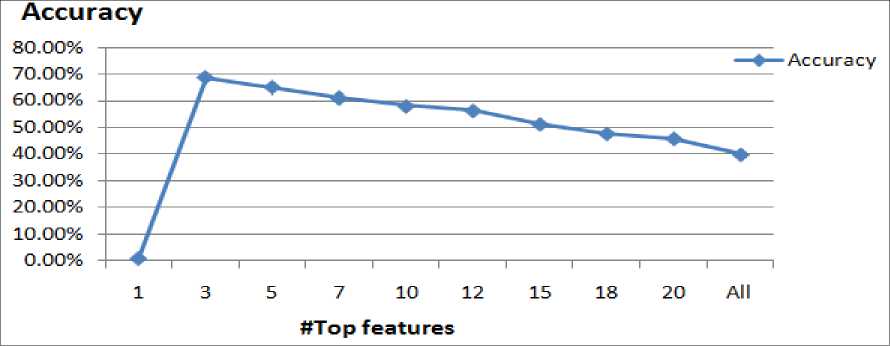
Fig.3. Effects of the number of top features on the performance of flat classification
-
C. Effects of the number of classes and documents on hierarchical classification
For the hierarchical classifier, we constructed a set of classifiers, one at each level of the classification tree. Thus, there was one classifier at level-0 (trained on the 8 level-1 classes), 8 classifiers for level-1 (one for each level- 1 class), and 20 classifiers for level-2(one for each level-2 class).
Table 3. Results of the hierarchical classifier along the hierarchy for sample classes
|
Classifier |
Training set |
Testing set |
Accuracy (%) |
|
|
Level-0 Classifier |
3570 |
1530 |
63.03 |
|
|
Level-1 Classifier |
Code 2 |
394 |
168 |
78.76 |
|
Code 4 |
399 |
170 |
81.155 |
|
|
Code 6 |
595 |
256 |
79.76 |
|
|
Level-2 Classifier |
Code 2.1 |
163 |
70 |
87.93 |
|
Code 2.2 |
161 |
68 |
90.37 |
|
|
Code 2.3 |
70 |
30 |
88.23 |
|
|
Code 4.1 |
176 |
75 |
85.71 |
|
|
Code 4.2 |
33 |
14 |
89.37 |
|
|
Code 4.3 |
190 |
81 |
86.01 |
|
|
Code 6.1 |
475 |
204 |
82.62 |
|
|
Code 6.2 |
120 |
52 |
85.56 |
|
-
D. Effects of Number of Top Features in Hierarchical Classifiers
The documents were initially classified at level-0 using a varying number of features per document where the features were selected based on their tf*idf weights. The first run used only the highest weighted feature for classifying the documents and number of features was increased in each subsequent run until a maximum of 20 features. The level-0 classifier had a peak accuracy of 81.50% when the top 5 features were used.
The test documents were then classified at level-1 while again varying the number of top features from 1 to 20. At level-1, the classification process is same as above, but it is constrained to consider only the subclasses of the best matching class at level-0. Hence, the level-1 classifier had a peak accuracy of 85.07% when the top 10 features were used.
Finally, the test documents were classified at level-2 with the classification process now constrained to consider only the subclasses of the best matching class at level-1. Since all the test documents originally came from level-2 classes, the accuracy of the classifier overall is best judged by the accuracy at level-2. The level-2 classifier had an exact match precision of 89.06% when the top 15 features were used. This means that, from a set of 97 classes, the hierarchical classifier correctly classified 89.06% of documents to their original class. The overall results of the experiment are shown in figure 4 below.
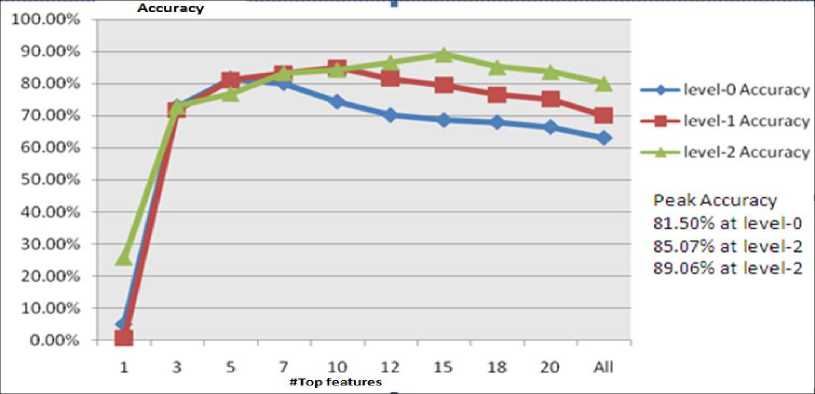
Fig.4. Effects of Number of Top Features in Hierarchical Classifiers
It is interesting to note that, as we move down the hierarchy, the classifiers perform better with more features extracted from test documents. This is because they need more information in order to make finergrained distinctions between the classes.
-
VI. Conclusion
As the advancements of technology, the mass production Amharic documents necessitated proper classification to meet the information needs of users. Hierarchical Amharic text classification approach shows good result in classifying documents into their predefined categories. Since, a hierarchical approach manages a huge collection of document in a divide-and-conquer approach; it simplifies a classification task focus on a smaller set of documents, those relevant to the task at hand. The experimental result also shows that the use of hierarchy for text classification results in a significant improvement of 29.42 % in exact match accuracy over the flat classifier.
Список литературы A Comparative Study of Flat and Hierarchical Classification for Amharic News Text Using SVM
- Rennie, Jason D. M. Improving Multi-Class Text Classification with Naive Bayes. Massachusetts Institute of Technology, Masters Thesis, 2001.
- Klein, B. Text Classification Using Machine Learning. Journal of Theoretical and Applied Information Technology. 2004.
- D'Alessio, S., Murray, K., Schiaf_no, R., & Kershenbaum, A. The effect of using hierarchical classifiers in text categorization. Proceeding of RIAO-00, 6 International Conferences, 2000.
- Koller & Sahami. Hierarchically classifying documents using very few words. The 14th national conference on machine learning. Computer Science department, Stanford University , 1997
- Ethnologue. 2004. Languages of the World, 14th Edition.
- Yohannes A. Automatic Amharic news text classification using Support Vector Machine approach. Department of Information Science, Addis Ababa University, Master's Thesis, 2007.
- Zelalem Sintayehu. Automatic Classification of Amharic News Items: The Case of Ethiopian News Agency. School of Information Studies for Africa, Addis Ababa University, Addis Ababa, 2001.
- Surafel Teklu. Automatic categorization of Amharic news text: A machine learning approach. Department of Information Science, Addis Ababa University, Masters Thesis, 2003.
- Worku K. Automatic Amharic News Text Classification: A Neural network approach. Department of Information Science, Addis Ababa University, Master's Thesis, 2009.
- Nega, Stemming of Amharic Words for Information Retrieval university of Sheffield, Sheffield, UK , 2002.
- J. Han and M. Kamber. Data Mining: Concepts and techniques (2nd ed.). Morgan Kaufmann Publishers, 2006.
- Yuchen Fu,Yuanhu Cheng. "Application of an integrated support vector regression method in prediction of financial returns". International Journal of Information Engineering and Electronic Business (IJIEEB), Vol.3, No.3, June 2011.
- Muhsin Hassan, et al." Reducing Support Vector Machine Classification Error by Implementing Kalman Filter", International Journal of Intelligent Systems and Applications(IJISA), Vol. 5, No. 9, August 2013.
- Le Hoang,et al. "Image Classification using Support Vector Machine and Artificial Neural Network", International Journal of Information Technology and Computer Science(IJITCS), Vol. 4, No. 5, Mayl 2012.
- F. Sebastiani. Machine learning in Automated Text Categorization-in ACM Computing surveys 34(1), 2002, pages 1-47.
- T. Joachims, Text categorization with support vector machines: learning with many relevant features, Proceedings of ECML 98, 10th European Conference on Machine Learning (Chemnitz, Germany, 1998). Pages 137–142.

